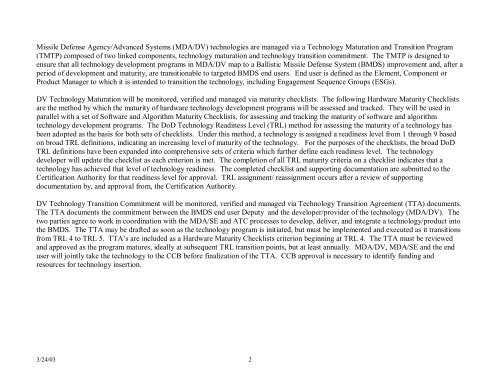MDA/DV HARDWARE MATURITY CHECKLISTS for TECHNOLOGY ...
MDA/DV HARDWARE MATURITY CHECKLISTS for TECHNOLOGY ...
MDA/DV HARDWARE MATURITY CHECKLISTS for TECHNOLOGY ...
Create successful ePaper yourself
Turn your PDF publications into a flip-book with our unique Google optimized e-Paper software.
Missile Defense Agency/Advanced Systems (<strong>MDA</strong>/<strong>DV</strong>) technologies are managed via a Technology Maturation and Transition Program<br />
(TMTP) composed of two linked components, technology maturation and technology transition commitment. The TMTP is designed to<br />
ensure that all technology development programs in <strong>MDA</strong>/<strong>DV</strong> map to a Ballistic Missile Defense System (BMDS) improvement and, after a<br />
period of development and maturity, are transitionable to targeted BMDS end users. End user is defined as the Element, Component or<br />
Product Manager to which it is intended to transition the technology, including Engagement Sequence Groups (ESGs).<br />
<strong>DV</strong> Technology Maturation will be monitored, verified and managed via maturity checklists. The following Hardware Maturity Checklists<br />
are the method by which the maturity of hardware technology development programs will be assessed and tracked. They will be used in<br />
parallel with a set of Software and Algorithm Maturity Checklists, <strong>for</strong> assessing and tracking the maturity of software and algorithm<br />
technology development programs. The DoD Technology Readiness Level (TRL) method <strong>for</strong> assessing the maturity of a technology has<br />
been adopted as the basis <strong>for</strong> both sets of checklists. Under this method, a technology is assigned a readiness level from 1 through 9 based<br />
on broad TRL definitions, indicating an increasing level of maturity of the technology. For the purposes of the checklists, the broad DoD<br />
TRL definitions have been expanded into comprehensive sets of criteria which further define each readiness level. The technology<br />
developer will update the checklist as each criterion is met. The completion of all TRL maturity criteria on a checklist indicates that a<br />
technology has achieved that level of technology readiness. The completed checklist and supporting documentation are submitted to the<br />
Certification Authority <strong>for</strong> that readiness level <strong>for</strong> approval. TRL assignment/ reassignment occurs after a review of supporting<br />
documentation by, and approval from, the Certification Authority.<br />
<strong>DV</strong> Technology Transition Commitment will be monitored, verified and managed via Technology Transition Agreement (TTA) documents.<br />
The TTA documents the commitment between the BMDS end user Deputy and the developer/provider of the technology (<strong>MDA</strong>/<strong>DV</strong>). The<br />
two parties agree to work in coordination with the <strong>MDA</strong>/SE and ATC processes to develop, deliver, and integrate a technology/product into<br />
the BMDS. The TTA may be drafted as soon as the technology program is initiated, but must be implemented and executed as it transitions<br />
from TRL 4 to TRL 5. TTA’s are included as a Hardware Maturity Checklists criterion beginning at TRL 4. The TTA must be reviewed<br />
and approved as the program matures, ideally at subsequent TRL transition points, but at least annually. <strong>MDA</strong>/<strong>DV</strong>, <strong>MDA</strong>/SE and the end<br />
user will jointly take the technology to the CCB be<strong>for</strong>e finalization of the TTA. CCB approval is necessary to identify funding and<br />
resources <strong>for</strong> technology insertion.<br />
3/24/03 2




